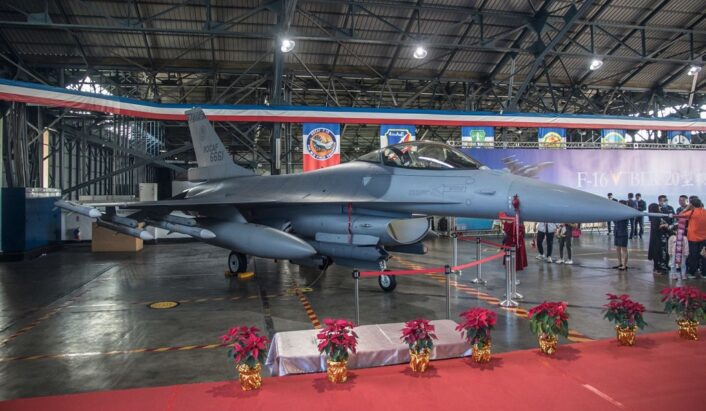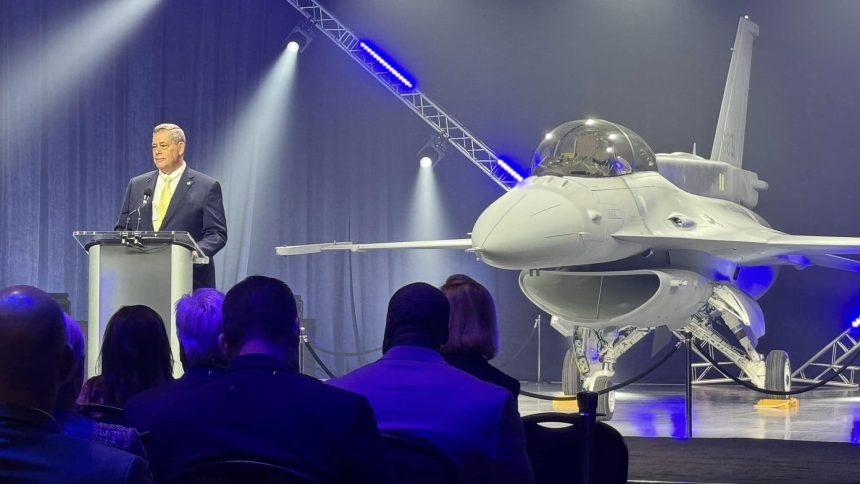Taiwan’s first new F-16, part of an order for 66 aircraft, was unveiled during a rollout ceremony at Lockheed Martin’s facilities.
Lockheed Martin has unveiled Taiwan first newly built F-16 Block 70 during a rollout ceremony at the company’s facilities in Greenville, South Carolina, on Mar. 28, 2025. The aircraft, an F-16D with serial number 6831, is the first of 66 F-16C/D Block 70s acquired in 2019 as part of a package worth $8 billion.
These 66 newly built aircraft will supplement the 139 already in service with the Republic of China Air Force (ROCAF), which have been upgraded from the initial F-16A/B Block 20 Mid-Life Update (MLU) configuration to the newer F-16V Block 70 configuration. The F-16V achieved the Final Operational Capability in 2021, with the final upgraded aircraft delivered in 2023.
Taiwan expected the delivery of the first newly built F-16 in 2024, however this was delayed due to software and supply chain issues. According to Aviation Week, the Taiwanese Ministry of National Defense said the first F-16 will arrive in the country in 2027, and all 66 aircraft will be handed over by the end of 2026.
The new jets, according to the Taipei Times, will be assigned 7th Tactical Fighter Wing to defend Taiwan’s eastern region. The publication also reported that President William Lai said, during an inspection of the unit in January 2025, that two out of its three tactical groups had been staffed and were waiting for delivery of the jets.
Man! Lockheed Martin sure knows how to put on a show! Yesterday, they held a delivery ceremony for the F-16 viper fighter jet to Taiwan. F-16s are the fighter jet platform flown by our awesome SC Air National Guard #SwampFox out of McEntire JNG Base#PeaceThroughStrength pic.twitter.com/yks2xJoQqq
— Phil Hamby (@Phil_Hamby) March 29, 2025
Taiwan’s new F-16s
The Taiwanese Ministry of National Defense (MND) stated that the F-16 Block 70 procurement was launched in response to “enemy threats and urgent national defense needs.” In 2019, the MND obtained the budget in accordance with the “Special Regulations for the Procurement of New Fighter Aircraft” to acquire the 66 new fighters.
The MND says that this deal demonstrates the U.S. government’s commitment to continue to assist Taiwan in improving its self-defense capabilities, in accordance with the “Taiwan Relations Act” and the “Six Assurances.” The latter are guidelines for the relations between the two countries that were adopted in 1982, under which the U.S. would not set a date for ending arms sales to Taiwan, nor would it consult with China regarding those arms sales.
The sale of the F-16 Block 70 was considered a ‘red line’ by China and only in 2019 the Foreign Military Sale was authorized, after years of wait. The new F-16s would also allow Taiwan to become the type’s largest fleet in South East Asia, with 205 aircraft in inventory.
The F-16 Block 70/72 are the most advanced production Vipers, which are newly built as opposed to the F-16V which are existing aircraft upgraded to the same configuration. So far, six countries have selected the F-16 Block 70/72 and Lockheed Martin has a production backlog of more than 100 jets.

Among the new systems installed during the upgrade we can find the APG-83 AESA (Active Electronically Scanned Array) radar, a new Center Pedestal Display (CPD), the AN/APX-126 Advanced IFF (Identification Friend or Foe), Link 16 datalink, full NVIS (Night Vision Imaging System) and JHCMS II (Joint Helmet-Mounted Cueing System II) compatibility, a new Embedded GPS/INS (EGI), a modern commercial off-the-shelf (COTS)-based avionics subsystem, a high-volume, high-speed data bus and the Automatic Ground Collision Avoidance System (Auto GCAS).
The APG-83 Scalable Agile Beam Radar (SABR), developed by Northrop Grumman, is an AESA (Active Electronically Scanned Array) radar designed to fit the F-16 with no structural, power or cooling modifications; in addition, it enables the F-16 to detect, track and identify a greater number of targets (reportedly more than 20 at the same time) faster and at longer ranges while providing all-weather, high-resolution Synthetic Aperture Radar (SAR) mapping. The system also integrated a robust electronic protection to operate in hostile electronic environments.
The Block 70 features a new cockpit concept, with the installation of a Center Pedestal Display (CPD), that provides the pilot with critical tactical data on a high resolution 6’’x8’’ screen. The new screen allows pilots to take full advantage of the new radar and targeting pod data, including new color moving map, a larger and easier representation of the air-to-air situational displays with zoom functionality and last but not least the ability to switch information among displays. Also, Taiwanese F-16s might have been equipped with the Martin Baker US18E seats.
Our first look at the Taiwanese Block 70. Fitted with Martin Baker US18Es here, I wouldn’t be surprised if the cockpit also includes some changes. This isn’t the baseline configuration. https://t.co/O9bDDm9wfA pic.twitter.com/zL0rmNBcuf
— Abd (@blocksixtynine) March 29, 2025
The F-16V program
Taiwan signed a contract to upgrade the fleet of F-16A/B Block 20 fighter jets in 2012, with the program dubbed “Peace Phoenix Rising”. Initially, it was decided to upgrade 144 Vipers (as the F-16 is called by the pilots), but three of those were later lost in mishaps and thus the final number of jets to be upgraded is 141, although two more have been later lost .
The first jet was upgraded as a prototype by Lockheed Martin at their facilities in Fort Worth (Texas) and flew for the first time in 2015, with Taiwan’s Aerospace Industrial Development Corporation (AIDC) taking over a year later the works to upgrade the F-16 locally. The work started slowly, with the first four F-16Vs delivered only in 2018, but then proceeded at a rhythm of at least 24 aircraft per year once all problems were solved. The retrofit of the whole fleet was planned to be completed by 2023, with the final aircraft delivered in December 2023.
In addition to the systems found on the Block 70, the upgrade program included a slew of structural upgrades to the wings, fuselage and landing gear. These allowed for increased Maximum Take Off Weight (MTOW) and Maximum Landing Weight (MLW), as well as make the aircraft more capable and sustainable.









